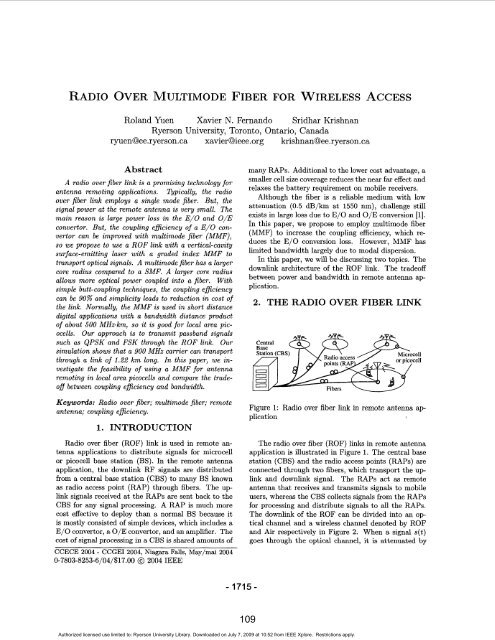Signal Analysis Research (SAR) Group - RNet - Ryerson University
Signal Analysis Research (SAR) Group - RNet - Ryerson University
Signal Analysis Research (SAR) Group - RNet - Ryerson University
You also want an ePaper? Increase the reach of your titles
YUMPU automatically turns print PDFs into web optimized ePapers that Google loves.
RADIO OVER MULTIMODE FIBER FOR WIRELESS ACCESS<br />
Roland Yuen Xavier N. Fernando Sridhar Krishnan<br />
<strong>Ryerson</strong> <strong>University</strong>, Toronto, Ontario, Canada<br />
r yuenaee. ryerson. ca xavier Qieee. org krishnanQee. ryerson. ca<br />
Abstract<br />
A radio over fiber link is a promising technology for<br />
antenna remoting applications. Typically, the radio<br />
over fiber link employs a single mode fiber. But, the<br />
signal power at the remote antenna is very small. The<br />
main reason is large power loss in the E/O and O/E<br />
convertor. But, the coupling efficiency of a E/O con-<br />
vertor can be improved with multimode fiber (MMF),<br />
so we propose to use a ROF link with a vertical-cavity<br />
surface-emitting laser with a graded index MMF to<br />
transport optical signals. A multimode fiber has a larger<br />
core radius compared to a SMF. A larger core radius<br />
allows more optical power coupled into a fiber. With<br />
simple butt-coupling techniques, the coupling eficiency<br />
can be 90% and simplicity leads to reduction in cost of<br />
the link. Normally, the MMF is used in short distance<br />
digital applications with a bandwidth distance product<br />
of about 500 MHDkm, so it is good for local area pic-<br />
ocells. Our approach as to transmit passband signals<br />
such as QPSK and FSK through the ROF link. Our<br />
simulation shows that a 900 MHz carrier can transport<br />
through a link of 1.22 km long. In this paper, we in-<br />
vestigate the feasibility of using a MMF for antenna<br />
remoting in local area picocells and compare the trade-<br />
08 between coupling efficiency and bandwidth.<br />
Keywords: Radio over fiber; multimode fiber; remote<br />
antenna; coupling eficiency.<br />
1. INTRODUCTION<br />
Radio over fiber (ROF) link is used in remote an-<br />
tenna applications to distribute signals for microcell<br />
or picocell base station (BS). In the remote antenna<br />
application, the downlink RF signals are distributed<br />
from a central base station (CBS) to many BS known<br />
as radio access point (RAP) through fibers. The up-<br />
link signals received at the RAPs are sent back to the<br />
CBS for any signal processing. A RAP is much more<br />
cost effective to deploy than a normal BS because it<br />
is mostly consisted of simple devices, which includes a<br />
E/O convertor, a O/E convertor, and an amplifier. The<br />
cost of signal processing in a CBS is shared amounts of<br />
CCECE 2004 - CCGEI 2004, Niagara Falls, May/mai 2004<br />
0-7803-8253-6/04/$17.00 @ 2004 IEEE<br />
- 1715 -<br />
many RAPs. Additional to the lower cost advantage, a<br />
smaller cell size coverage reduces the near fax effect and<br />
relaxes the battery requirement on mobile receivers.<br />
Although the fiber is a reliable medium with low<br />
attenuation (0.5 dB/km at 1550 nm), challenge still<br />
exists in large loss due to E/O and O/E conversion [l].<br />
In this paper, we propose to employ multimode fiber<br />
(MMF) to increase the coupling efficiency, which re-<br />
duces the E/O conversion loss. However, MMF has<br />
limited bandwidth largely due to modal dispersion.<br />
In this paper, we will be discussing two topics. The<br />
downlink architecture of the ROF link. The tradeoff<br />
between power and bandwidth in remote antenna ap-<br />
plication.<br />
109<br />
2. THE RADIO OVER FIBER LINK<br />
Figure 1: Radio over fiber link in remote antenna ap-<br />
plication i<br />
The radio over fiber (ROF) links in remote antenna<br />
application is illustrated in Figure 1. The central base<br />
station (CBS) and the radio access points (RAPs) are<br />
connected through two fibers, which transport the up-<br />
link and downlink signal. The RAPs act as remote<br />
antenna that receives and transmits signals to mobile<br />
users, whereas the CBS collects signals from the RAPs<br />
for processing and distribute signals to all the RAPs.<br />
The downlink of the ROF can be divided into an op-<br />
tical channel and a wireless channel denoted by ROF<br />
and Air respectively in Figure 2. When a signal s(t)<br />
goes through the optical channel, it is attenuated by<br />
Authorized licensed use limited to: <strong>Ryerson</strong> <strong>University</strong> Library. Downloaded on July 7, 2009 at 10:52 from IEEE Xplore. Restrictions apply.


